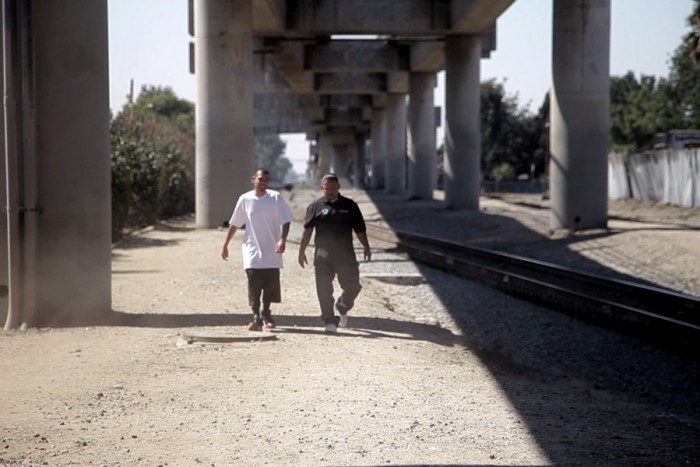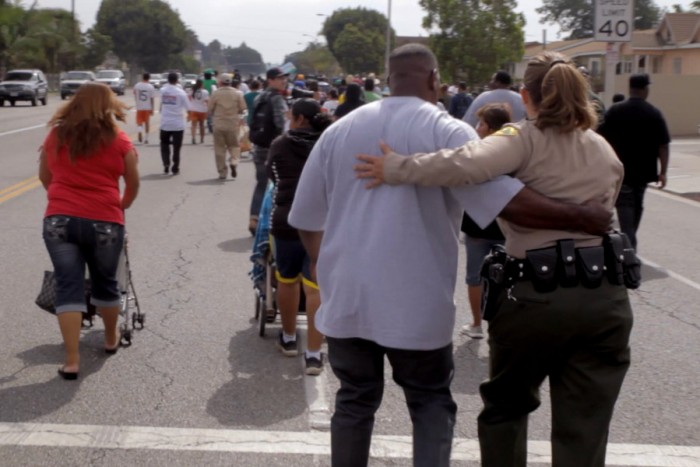
If ever there was a time to find hope in a true story, it is now. The movie “License to Operate” documents former gang members working with police officers to cultivate a safe community and reduce gang violence. The documentary delivers that hope— and offers a glimmer of a similar outcome in Seattle.
“License to operate” is the term used for former gang members who have gone through extensive training in intervention work. The film followed outreach workers with A Better L.A. Foundation, highlighting the experiences of Alfred Lomas, Reynaldo Reaser, and ABLA Executive Director and trainer Aquil Basheer.
The organization was founded in 2003 by then-University of Southern California football coach Pete Carroll, now of the Seattle Seahawks. Carroll was also executive producer of the movie—and created a similar foundation here called A Better Seattle.
While Carroll founded the group in Los Angeles, Basheer and other hands-on trainers brought the street credibility with their experiences as gang members.
According to LAPD Chief Charlie Beck, this revolutionary model of intervention has reduced gang violence in Los Angeles by 50 percent.
Los Angeles is home to more than 450 gangs. At the height of violence in 1992, 1,013 people were killed by gang-related violence.
“I guess the one thing that I would like for someone to be able to say about me, when that time comes is that I was man enough to stand up for change,” said Lewis Battee, a trained operator and director of Advocates for Peace and Urban Unity.
That sentiment is the basis not simply for the film, but for a peaceful movement. The people who have lost love ones — and themselves— to gang violence are the ones standing up and saying, “No more.”

For example, Alfred Lomas is a veteran both of the US marines and one of the most violent gangs in LA. After various near-death experiences, Lomas decided to change his life. He began by directing a food truck outreach program that made food accessible to low-income families in dangerous neighborhoods.
Reynaldo Reaser and his wife, Renee, were also no strangers to gang life. They found themselves saddened and frustrated by the violence and ready to work towards a solution. These stories are echoed by several people in the movie.
And it’s working. Where police tactics alone have failed, this partnership has succeeded in reducing the murder rate to around 300 a year.
“The reason we’re able to go in and do what we do is that the people we deal with understand that we understand the culture. We understand the dynamic of what they’re going through.” ABLA executive director Aquil Basheer said, after the film premiered this year at SIFF. “It’s never talking down to them, it’s talking at their level , it’s talking with them and understanding what they’re going through.”
But first a lot of talking had to be done across communities. The stakeholders were diverse and at times adversarial. Many police balked at working with criminals and many former gang members didn’t want to be labeled as snitches for working with police. But the common goal of cultivating a safe community was stronger than the fear or the mistrust on either side.
The intervention specialists were trained by Basheer. Basheer, a former gang member and Black Panther, is also the founder of the Professional Community Intervention Training Institute.
When it became clear that what they were doing was working, many cities have tried to create similar models, including Seattle.
Carroll founded A Better Seattle in 2011, following the same protocols as the programs in Los Angeles.
“Seattle’s a little different from Los Angeles in terms of geographic isolation and in terms of the whole mechanics of how that structure operates and that’s why you create the infrastructure but then you let that city lead the process,” Basheer said.
“So much of what you see in Seattle came from Los Angeles,” Basheer said. “Seattle was a safe haven in the 90s and so many of the gang members from Los Angeles came up here because they knew they could settle in here and that’s exactly what happened. “
While Seattle’s murder rate is not even close to triple digits and we have far fewer gangs and fewer people involved in gang violence, the philosophy behind A Better Seattle is that even one lost life is too many.
A Better Seattle is responsible for the Seattle Youth Violence Prevention Initiative ushered in by former Mayor Greg Nickels. SYVPI has been a source of funding to train peacekeepers and provides alternative programming for youth through the YMCA Alive and Free Street Outreach, Urban Families, and many other community organizations.
“My wife and I founded the Urban Family. Our big idea is really a simple idea, building support around marginalized urban youth. When I say urban youth I don’t mean black youth only, but really multi-ethnic people from the city that are dealing with urban issues,” said Paul Patu, one of the intervention specialists trained by Basheer here in Seattle. “When Aquil’s training came along it really kind of added the safety aspect of the work that we do.”
Patu, a Seattle native, says he has a family history of peacekeeping. “Because my mother has been doing this kind of work for years, early on in Seattle’s kind of young history with gang life she was part of a team that helped to mitigate the Crips and Bloods back then.”
Gang life is not just a fad, Patu said. “And the youth culture has been somewhat like a chameleon where we go through phases of culture that we try on like a jacket and then take off after we’re finished with them, but the issues of gangs, we were never able to peel that off again. Once gangs hit Seattle they kind of lingered and stayed. “
Though the film only focused on L.A., it left me thinking about Seattle. SYVPI has effectively provided a diverse set of opportunities for youth from employment to case management. Programs like the Urban Authors allow youth to learn to write and self-publish books. But it’s unclear from the way Seattle Police tracks their statistics as to whether these measures have helped curb violence. But perhaps numbers aren’t the only metrics for success.
Patu said creating relationships with youth before attempting to intervene is important.
“For me exposure was the key. The reason why I’m different from the rest of the kids I grew up around is that I was exposed to mentorship and those caring adult relationships,” Patu said.
Perhaps the biggest impact of Carroll’s vision for A Better LA and A Better Seattle is that everyone is able to see it to and engage in it.


Reagan – Dig a little deeper. This is a Promo piece. While there is amazing intervention work going on in LA- some of what you see is the people who have the money to self-promote taking credit for something that is not quite what it seems. It is a promo piece for one organization — dig a little deeper, please.
Hi Sally thanks for the feedback. What you describe is what I expected to find, a Pete Carroll used white privilege to do some good in the hood film, but in fact the way it was presented was much more community driven than I initially thought. Have you had a chance to see the film?